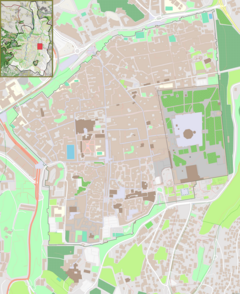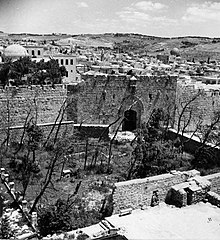This is an old revision of this page, as edited by Lollipoplollipoplollipop (talk | contribs) at 07:02, 22 June 2020 (Adding local short description: "Gate in Jerusalem's Old City Walls", overriding Wikidata description "one of seven open Gates in Jerusalem's Old City Walls" (Shortdesc helper)). The present address (URL) is a permanent link to this revision, which may differ significantly from the current revision.
Revision as of 07:02, 22 June 2020 by Lollipoplollipoplollipop (talk | contribs) (Adding local short description: "Gate in Jerusalem's Old City Walls", overriding Wikidata description "one of seven open Gates in Jerusalem's Old City Walls" (Shortdesc helper))(diff) ← Previous revision | Latest revision (diff) | Newer revision → (diff) Gate in Jerusalem's Old City Walls| Zion Gate | |
|---|---|
 Zion Gate Zion Gate | |
 | |
| General information | |
| Town or city | Jerusalem |
| Coordinates | 31°46′22.3″N 35°13′45.7″E / 31.772861°N 35.229361°E / 31.772861; 35.229361 |
Zion Gate (Template:Lang-he, Sha'ar Zion, Template:Lang-ar, Bab Sahyun) also known in Arabic as Bab Harat al-Yahud ("Jewish Quarter Gate"), or Bab an-Nabi Dawud ("Prophet David Gate"), is one of eight Gates of the Old City of Jerusalem.
History

Zion Gate was built in July 1540, west of the location of the medieval gate, which was a direct continuation of the Street of the Jews (also known the Cardo). Six sentry towers were erected in the southern segment of the wall, four of them situated in the Mount Zion section.
In the second half of the nineteenth century, a leper colony, slaughter house and livestock market were situated in the vicinity of Zion Gate. Towards the end of the nineteenth century, shops were built along the length of the southern wall which were torn down during the British Mandate.
On May 13, 1948, as the British Army withdrew from Jerusalem, a major from the Suffolk Regiment presented Mordechai Weingarten with the key for the Zion Gate.

In 2008, restoration work was carried out on the gate, marking its 468th birthday.
See also
References
- Johannes Pahlitzsch; Lorenz Korn (2004). Governing the Holy City: the interaction of social groups in Jerusalem between the Fatimid and the Ottoman period. Reichert. p. 122. ISBN 978-3-89500-404-9. Retrieved 24 May 2011.
- The Conservation of Jerusalem's City Walls
- Joseph, p.69: 'and a sten gun and ammuntion'. Collins/Lapierre, p.10: 'a bar of rusted iron about a foot long.'
- This story was repeated by President George W. Bush in his address to the Knesset on the 60-year anniversary of the creation of the State of Israel. 'a short iron bar'
- Preservation project marks 468th birthday of Jerusalem's Zion Gate
31°46′22.3″N 35°13′45.7″E / 31.772861°N 35.229361°E / 31.772861; 35.229361
Categories: